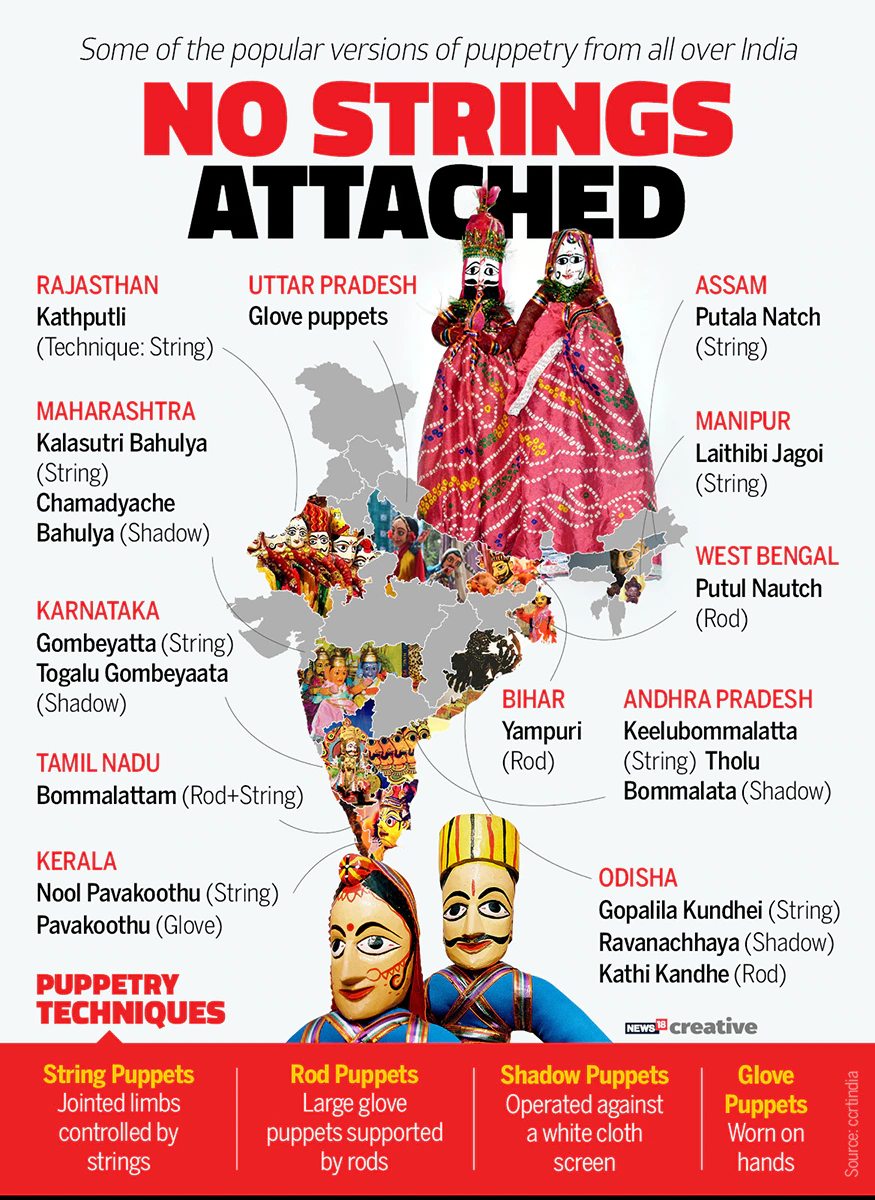AFSPA extended in parts of Arunachal, Nagaland for six more months.
|
Disturbed Area |
|
The Armed Forces (Special Powers) Act (AFSPA), 1958, was completely withdrawn in Meghalaya in 2018, Tripura in 2015 and Mizoram in the 1980s.
The Sangeet Natak Akademi began the revival of leather puppetry, by grooming young disciples through ‘Kala Diksha’ initiative that aims at preserving traditional arts and crafts in India.

|
Types of Puppets |
||
|
String Puppets |
||
|
||
|
Puppet Form |
State |
Features |
|
Kathputli |
Rajasthan |
|
|
Kundhei
|
Odisha |
|
|
Gombeyatta |
Karnataka |
|
|
Bommalattam |
Tamil Nadu |
|
|
Shadow Puppets |
||
|
||
|
Puppet Form |
State |
Features |
|
Togalu Gombeyatta |
Karnataka |
|
|
Tholu Bommalata |
Andhra Pradesh |
|
|
Ravanachhaya |
Odisha |
|
|
Rod Puppets |
||
|
||
|
Puppet Form |
State |
Features |
|
Putul Nautch |
West Bengal |
|
|
Orissa |
|
|
|
Yampuri |
Bihar |
|
|
Glove Puppets |
||
|
||
|
Puppet Form |
State |
Features |
|
Pavakoothu
|
Kerala |
|
The first evidence of puppets were found in Egypt around 2000 B.C.
|
Quick Facts |
|
Sangeet Natak Akademi |
|
|
World Puppetry Day |
|
Red Fort was recognised UNESCO World Heritage Centre in 2007.
|
Mughal Architecture |
||||||||||||
|
||||||||||||
European Union investigates Tech giants under new digital Law.
Lalit Kala Akademi chief’s powers curbed by Culture Ministry.
The Sangeet Natak Akademi (SNA) was the first of the three to be established in 1953, followed shortly by Lalit Kala Akademi (LKA), and Sahitya Akademi (SA).
|
Other Important Topics |
|
C-Vigil App |
|
|
'Meghayan-24' |
|
'Meghayan-24', seminar was conducted recently as part of the World Meteorological Day (March 23).
INDRA (Indian Naval Dynamic Resource for Weather Analysis)
|
|
Solar waste in India |
|
A recent study says that India generated about 100 kilotonnes (kt) of solar waste in the financial year (FY) 2022-2023.
|
|
Chandra X-ray Observatory |
|
|
Cotoneaster Cambricus |
|
|
South East Africa Montane Archipelago (SEAMA) |
|
A recent study has unearthed a wealth of previously undocumented biodiversity in a newly recognised ecoregion called the South East Africa Montane Archipelago (SEAMA).
|
|
Nuclear Energy Summit |
|
Brussels hosted a first-of-its-kind Nuclear Energy Summit, billed as the most high-profile international meeting on nuclear energy ever.
|
|
White Rabbit Technology |
|
CERN launches the White Rabbit Collaboration.
|